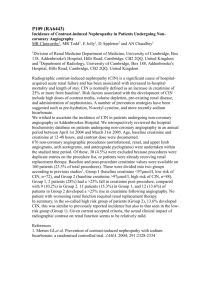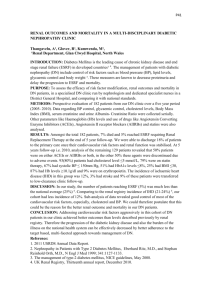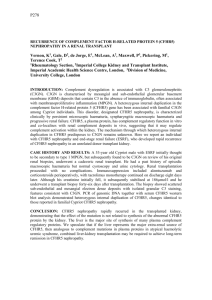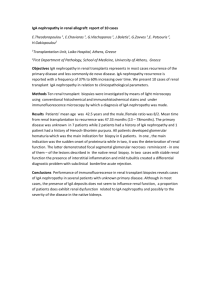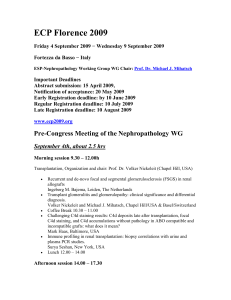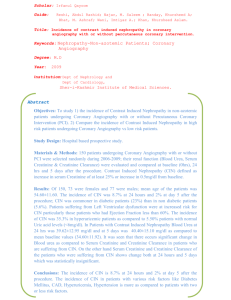Contrast induced nephropathy is a common and
advertisement
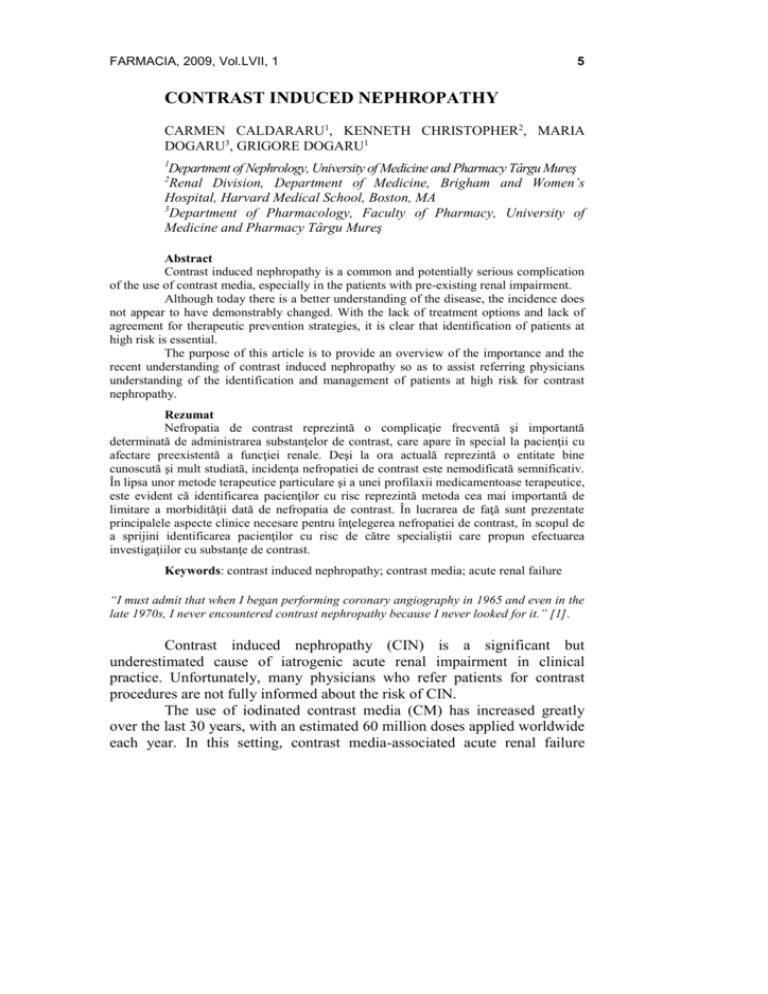
FARMACIA, 2009, Vol.LVII, 1 5 CONTRAST INDUCED NEPHROPATHY CARMEN CALDARARU1, KENNETH CHRISTOPHER2, MARIA DOGARU3, GRIGORE DOGARU1 1 Department of Nephrology, University of Medicine and Pharmacy Târgu Mureş Renal Division, Department of Medicine, Brigham and Women’s Hospital, Harvard Medical School, Boston, MA 3 Department of Pharmacology, Faculty of Pharmacy, University of Medicine and Pharmacy Târgu Mureş 2 Abstract Contrast induced nephropathy is a common and potentially serious complication of the use of contrast media, especially in the patients with pre-existing renal impairment. Although today there is a better understanding of the disease, the incidence does not appear to have demonstrably changed. With the lack of treatment options and lack of agreement for therapeutic prevention strategies, it is clear that identification of patients at high risk is essential. The purpose of this article is to provide an overview of the importance and the recent understanding of contrast induced nephropathy so as to assist referring physicians understanding of the identification and management of patients at high risk for contrast nephropathy. Rezumat Nefropatia de contrast reprezintă o complicaţie frecventă şi importantă determinată de administrarea substanţelor de contrast, care apare în special la pacienţii cu afectare preexistentă a funcţiei renale. Deşi la ora actuală reprezintă o entitate bine cunoscută şi mult studiată, incidenţa nefropatiei de contrast este nemodificată semnificativ. În lipsa unor metode terapeutice particulare şi a unei profilaxii medicamentoase terapeutice, este evident că identificarea pacienţilor cu risc reprezintă metoda cea mai importantă de limitare a morbidităţii dată de nefropatia de contrast. În lucrarea de faţă sunt prezentate principalele aspecte clinice necesare pentru înţelegerea nefropatiei de contrast, în scopul de a sprijini identificarea pacienţilor cu risc de către specialiştii care propun efectuarea investigaţiilor cu substanţe de contrast. Keywords: contrast induced nephropathy; contrast media; acute renal failure “I must admit that when I began performing coronary angiography in 1965 and even in the late 1970s, I never encountered contrast nephropathy because I never looked for it.” [1]. Contrast induced nephropathy (CIN) is a significant but underestimated cause of iatrogenic acute renal impairment in clinical practice. Unfortunately, many physicians who refer patients for contrast procedures are not fully informed about the risk of CIN. The use of iodinated contrast media (CM) has increased greatly over the last 30 years, with an estimated 60 million doses applied worldwide each year. In this setting, contrast media-associated acute renal failure 6 FARMACIA, 2009, Vol.LVII, 1 represents the third most common cause of in-hospital renal function deterioration after decreased renal perfusion and post-operative renal insufficiency [2] causing not only significant morbidity and mortality, but an increase of hospital length of stay and costs. The purpose of this article is to provide an overview of the importance and the recent understanding of this condition helping referring physicians to understand how to identify and manage the patients at high risk. Definition Although there is no universally accepted definition, contrast agent nephropathy is usually defined as impairment of renal function occurring within 48 hours after administration of contrast media. Contract Induced Nephropathy is also known as contrast nephropathy, contrast nephrotoxicity, contrast media nephropathy, contrast agent nephropathy and radiocontrast-induced nephropathy. The multiplicity of names is, perhaps, emblematic of the level of understanding of this condition. The most common definition of CIN is an increase of 25% or more, or an absolute increase of 0.5 mg/dl or more in serum creatinine from baseline value, at 48–72 h following the exposure to contrast media [3]. The definition of CIN includes three necessary components: an absolute or relative increase in serum creatinine as compared to baseline, a temporal relationship between the rise in serum creatinine and exposure to a contrast agent, and the exclusion of alternative explanations for renal impairment (e.g. cholesterol embolism). The degree of increase in creatinine in definitions used in various studies has a rather wide range (20%–50%), making difficult the comparison of the results and the assessment of the true incidence of CIN. Because creatinine peaks between four and five days after contrast administration, CIN may escape in a considerable number of patients relying on the creatinine concentration assessed only up to 48 h. Furthermore, serum creatinine is an inaccurate estimate of creatinine clearance [4], which is better calculated according to the formula of Cockcroft and Gault or the modification of diet in renal disease (MDRD) study equation when the patient is in a steady state. Epidemiology The great variation in studies assessing the incidence of CIN is explained by multiple factors: the type of study (prospective or retrospective), the definition of CIN, prophylactic measures and different risk factors evaluated [5]. FARMACIA, 2009, Vol.LVII, 1 7 In the general population, the incidence of CIN is between 1 to 6% of hospitalized patients, with a peak of 50% in high risk patients [6, 7]. In a retrospective analysis Rihal and colleagues showed that of 7586 patients undergoing percutaneous coronary intervention 3,3% experienced acute kidney injury (AKI) as defined as an increase in serum creatinine with more than 0,5 mg/dl from baseline after contrast administration. Among hospital survivors with AKI, 1- and 5-year estimated mortality rates were 12.1% and 44.6%, respectively, much greater than the 1- and 5-year mortality rates in patients without AKI (3.7% and 14.5% respectively, P<0.0001) [8]. Prospective studies have also produced extremely varied estimates of the incidence of CIN. These discrepancies are easily explained by the differences in the definition of renal failure as well as differences in patient comorbidities and the presence of other potential causes of acute renal failure. In a series of approximately 1800 consecutive patients undergoing invasive cardiac procedures, McCullough et al reported an incidence of acute renal failure or acute renal failure requiring dialysis of 14.5%. [9] McCullough also demonstrated that patients who develop CIN have high inhospital mortality and poor long-term survival.[9] Pathophysiology The pathophysiology of CIN is not fully understood. Prolonged vasoconstriction and impaired autoregulation induced by the contrast media predispose the medulla to hypoxia. Medullary hypoxia combined with a direct cytotoxic effect of contrast media are the most important factors in the development of CIN. In addition, generation of reactive species, changes in blood rheology or some systemic factors like hypovolaemia or changes in calcium physiology can contribute to the development of this condition [10]. Contrast agents Most contrast media in use are complex organic compounds of iodine, their function being closely related to the chemical structure. Iodinated contrast media are categorized on the basis of their osmolality which is determined by the ratio of iodine atoms to osmotically active particles [11]. There are three categories of contrast media: high-osmolar contrast media are approximately 2,000 mOsm/kg H2O - all of the available highosmolar media are ionic, low-osmolar contrast media are 600 to 800 mOsm/kg H2O - some are ionic and some are nonionic and iso-osmolar contrast is 290 mOsm/kg H2O- are nonionic. 8 FARMACIA, 2009, Vol.LVII, 1 Osmolality of contrast media seems to be the most important characteristics for CIN; in some studies low- and iso-osmolal agents being associated with a relative decreased incidence of renal injury [12]. In a meta-analysis of data from 2727 patients, McCullough and colleagues showed that use of isoosmolar iodixanol is associated with smaller rises in serum creatinine and lower rates of CIN than low-osmolar contrast media, especially in patients with chronic kidney disease [13]. Unfortunately, the literature is confusing even in this case. The CARE study was a direct comparison of the renal tolerability of the lowosmolality contrast medium iopamidol with that of the iso-osmolality contrast medium iodixanol in high-risk patients, but the result does not support any clinically significant difference between the agents [14]. Even with the uncertainty regarding the degree of nephrotoxicity attributable to the osmolality of contrast media, in current practice non ionic low-osmolar contrast media are preferred for patients with renal impairment. The volume of contrast seems to be important for CIN development especially in patients with pre-existing renal impairment, despite the fact that some studies reported no relationship between the amount of contrast administrated and the occurrence of renal impairment [14]. In a study on a diabetic population, Nikolski and colleagues showed that each 100 ml increment in contrast volume resulted in 30% increased in the odds of CIN (OR 1.30, 95% confidence interval 1.16-1.46) [15]. Clinical presentation The increase in serum creatinine levels is observed within 24 hours after the administration of contrast medium. Creatinine levels typically peak on the second and third day following contrast, returning to baseline values within two weeks. Acute renal failure due to contrast- induced nephropathy is generally nonoliguric and reversible [16, 17]. Mild proteinuria may also be observed. Because contrast media in urine may interfere with some of the protein, assay techniques can lead to false positive results. This is probably a pH effect and care must be exercised in interpreting tests for proteinuria in the presence of any contrast agent in the urine. Although unusual, there are reports of persistent elevation of serum creatinine or for progression to end-stage renal disease which may be related to concomitant cholesterol emboli. Risk factors A large number of factors have been associated with the development of CIN: pre-existing renal impairment, diabetes mellitus, FARMACIA, 2009, Vol.LVII, 1 9 reduction of effective intravascular volume (congestive heart failure, liver cirrhosis, nephrosis, diuretic treatment), hypotension (induced by diuretics or ACE inhibitors), sepsis, advance age, metabolic multiple myeloma, hyperuricaemia, hypercalcemia, concomitant potential nephrotoxic medication (NSAIDs, aminoglycoside, antibiotics, etc) volume and type of contrast media [18]. Prior renal impairment has been identified as the greatest independent predictor of CIN; the condition directly correlates with the incidence of CIN [19]. In one study performed on patients with renal transplant, the incidence of CIN was 21.2%, being especially high (42.8%) among those who have not received pre-procedure hydration [20]. Diabetes mellitus seems to be an independent risk factor; the association between chronic kidney disease and diabetes mellitus increases the risk of CIN to 50% [21]. The incidence of CIN in diabetic patients varies from 5.7 to 29.4% [15]. In an attempt to assess the influence of diabetic and pre-diabetic state on the development of contrast-induced nephropathy (CIN) in chronic kidney disease patients undergoing coronary angiography, Toprak demonstrated that patients with diabetes mellitus are at a higher risk of developing CIN, but patients with pre-diabetes mellitus are not at as high a risk for developing CIN as diabetes patients [22]. It is impossible to assess the independent role of risk factors in renal impairment after contrast administration. Some authors showed that there is an exponential relationship between the risk of renal impairment and the number of risk factors [23]. Recently, attempts have been made to develop risk scores in order to stratify the risk of CIN in patients undergoing coronary angiography [24]. In a study performed on 208 patients with coronary angioplasty Marenzi and colleagues showed that the incidence of contrast nephropathy was 19% and that age and volume of contrast were independent predictors of CIN [25]. Prophylactic measures CIN is a form of acute kidney injury (AKI) which can be prevented because the administration of contrast agents is planned in the majority of cases, so the population with a higher risk can be identified before procedure. Several agents have been suggested for CIN prevention including hydration, dopamine, N-acetylcysteine, atrial natriuretic peptide, alprostadil, etc. 10 FARMACIA, 2009, Vol.LVII, 1 Hydration Observations comparing hydrated patients with controls shows that volume supplementation is the best measure for preventing CIN [26]. It is considered that the effectiveness of this measure is definitely proved. For CIN prevention normal saline is administered at a rate of 1ml/kg of body weight/hour for 12 hours before the radiocontrast procedure and for 6-12 hours after the last dose of radiocontrast [27]. The effectiveness of saline volume supplementation is now well documented by observational as well as randomized studies. Moreover, a very low incidence of CIN was obtained using intravenous volume supplementation started on the day of percutaneous coronary intervention combined with strongly encouraged oral fluids after the intervention [28]. Dussol and colleagues demonstrated, in a study on 312 patients with chronic renal failure, that oral saline hydration was as efficient as intravenous saline hydration for the prevention of CIN and that furosemide and theophylline were not protective [29]. In addition to timing and route of hydration, other factors, such as fluid tonicity and fluid composition, may also play a role. In a group of 1620 patients scheduled for coronary angioplasty, Mueller and al showed that isotonic hydration is superior to half-isotonic hydration for prevention of CIN [30]. The REMEDIAL trial compared 326 patients with chronic kidney disease (GFR < 40 ml/min/1,73m2) with three prophylactic strategies: the administration of 0,9% saline plus NAC or sodium bicarbonate infusion plus NAC or 0,9% saline plus ascorbic acid plus NAC; the second one (bicarbonate infusion plus NAC) was superior in preventing CIN [31]. Apart from normal saline, other intravenous solutions have been used to test their effectiveness regarding CIN prevention. Sodium bicarbonate may provide additional renoprotection by alkalinizing renal tubular fluid and thereby minimizing tubular damage. Pretreatment with sodium bicarbonate is more protective than sodium chloride in animal models of acute ischemic renal failure. Trying to examine the efficacy of sodium bicarbonate compared with sodium chloride for prevention after radiographic contrast, in a prospective, randomized, double-blind placebo-controlled trial, Merten et al demonstrated that hydration with sodium bicarbonate before contrast exposure is more effective than hydration with sodium chloride for prophylaxis of contrast-induced renal failure [32]. FARMACIA, 2009, Vol.LVII, 1 11 Antioxidants Used primary as a mucolytic agent, N-acetylcysteine (NAC) is an abundant source of sulfhydryl groups, its metabolites being able to act as free radical scavengers and thus attenuate the cytotoxic effects of contrast media [33]. NAC is inexpensive and without significant side effect. The improvement in renal function induced by post-contrast administration of N-acetylcysteine (NAC) is strongly associated with suppression of oxidant stress-mediated proximal tubular injury [34]. Recent meta-analyses have shown an important role of NAC in reducing the risk of CIN especially when combined with hydration [35, 36]. In a randomized trial Marenzi and colleagues noted that intravenous and oral N-acetylcysteine may prevent contrast-medium–induced nephropathy with a dose-dependent effect in patients treated with primary angioplasty [35]. Results are inconstant because there are authors who showed that oral NAC does not prevent CIN in patients with low to moderate risk [37, 38]. A meta-analysis based on prospective studies on N-acetylcysteine and the incidence of radiocontrast nephropathy suggests that the role of oral NAC in the prevention of radiocontrast-induced nephropathy has yet to be defined, so it is impossible to make a recommendation for its routine use [39]. Ascorbic acid is a potent, water-soluble antioxidant who may protect against CIN in high-risk patients following oral administration in patients with preexisting renal dysfunction [40]. Drugs acting on the renal circulation Fenoldopam Fenoldopam mesylate is a selective dopamine-1 receptor agonist that produces renal arterial vasodilatation, an increase of blood flow and glomerular filtration rate. It had been postulated that these renal hemodynamic effects might effectively prevent CIN. In a study on 315 patients with creatinine clearance less than 60 ml/min, fenoldopam does not prevent further deterioration of renal function after contrast administration [41]. The benefit of fenoldopam has not been validated in large studies, thus routine use of the drug is not recommended in the prevention of CIN. Dopamine Dopamine acts at specific dopaminergic receptors in the kidney and in low doses (1.0-2.5 µg/kg per minute) might selectively dilate renal arterioles and counter the renal hemodynamic effects of contrast media, the presumed benefit of dopamine being the maintenance of glomerular perfusion. Unfortunately, dopamine does not offer renal protection in CIN [42]. 12 FARMACIA, 2009, Vol.LVII, 1 Some investigators even suspect that dopamine might increase patients mortality which could be related to the positive chronotrop effects of this catecholamine [43]. Theophylline Contrast media stimulate the intrarenal secretion of adenosine, which binds to the renal adenosine receptor and acts as a potent vasoconstrictor, primarily in the efferent arterioles, reducing renal blood flow. In experimental animals this vasoconstrictive response can be blunted with theophylline. Findings about the protective effect of theophylline are inconsistent. In a meta-analysis of 9 randomized trials involving 585 patients, Bagshaw et al concluded that theophylline may reduce the incidence of CIN with an efficacy comparable to that reported in studies of NAC [44]. Other studies shows that theophylline prophylaxis significantly reduced the incidence of CIN (4% versus 16%, p=.046) in patients with chronic renal insufficiency [45], or that the prophylaxis of CIN with theophylline is superior to acetylcysteine in patients who are admitted to intensive care unit. Atrial Natriuretic Peptide Atrial natriuretic peptide (ANP) may have a benefit in reducing CIN incidence by increasing glomerular filtration and renal blood flow. Clinical studies have not yet demonstrate that ANP treatment can reduce the risk of CIN, so ANP cannot be recommended for prophylaxis of CIN [46]. Hemodialysis and hemofiltration Because hemodialysis effectively removes radiocontrast, “prophylactic hemodialysis” has been proposed to prevent contrast-induced nephropathy especially in patients with GFR < 30 ml/min. In a study on 113 patients with advanced renal insufficiency undergoing different procedures with administration of nonionic, lowosmolality contrast agent it was not demonstrated any benefit of hemodialysis [47]. Hemofiltration is another form of renal-replacement therapy proposed to prevent CIN. In a group of 114 patients with chronic renal failure who are undergoing percutaneous coronary interventions, periprocedural hemofiltration given in an ICU setting appears to be effective in preventing the deterioration of renal function due to contrast-agent– FARMACIA, 2009, Vol.LVII, 1 13 induced nephropathy and is associated with improved in-hospital and longterm outcomes [48]. Conclusions Contrast induced nephropathy is an iatrogenic disorder, resulting from administration of contrast media. The condition occurs more frequently in patients with underlying renal dysfunction or other well defined risk- factors which acts synergistically to increase the probability of developing acute renal failure. Because treatment is limited only to supportive measures until renal function improvement, and because of associated significant morbidity and mortality with raised hospital length of stay and costs, high-risk patients must be recognised. After a careful risk-benefit analysis before referral to contrast agents investigations, there are four strategies to be mindful of to prevent CIN: 1) IV isotonic NaCl or NaHCO3 hydration, 2) iso-osmolar contrast in high risk patients with limited volume of contrast to < 100 ml for interventional cases, 3) consideration of pre-, intra-, and postprocedural endorgan protection with high dose antioxidants, 4) and postprocedural monitoring and expectant care. References 1. 2. 3. 4. 5. 6. 7. 8. Conti RM – Contrast nephropathy or contrast creatininopathy, Clin. Cardiol., 2003, 26: 53-54 Nash K, Hafeez A, Hou S. Hospital-acquired renal insufficiency. Am J Kidney Dis 2002; 39: 930–936 Mehran R, Nikolsky E - Contrast-induced nephropathy: Definition,epidemiology, and patients at risk, Kidney International, 2006, 69: S11–S15 Levey AS, Bosch JP, Lewis JB, Greene T, Rogers N, Roth D. A more accurate method to estimate glomerular filtration rate from serum creatinine: a new prediction equation: modification of diet in renal disease study group. Ann Intern Med 1999;130:461–470 Lepor NE, Mathur VS - Radiocontrast nephropathy. Current Interventional Cardiology Reports, 2000, 2: 335-341 Waybill MM, Waybill PN - Contrast media-induced nephrotoxicity: identification of patients at risk and algorithms for prevention. J.Vasc.Interv.Radiol., 2001, 12: 3-9 Murphy SW, Barrett BJ, Parfrey PS - Contrast nephropathy J.Am.Soc.Nephrol., 2000, 11: 177-182 Rihal CJ, Textor SC, Grill DE et al - Incidence and prognostic importance of acute renal failure after percutaneous coronary intervention. Circulation 2002, 105: 2259-2264 14 FARMACIA, 2009, Vol.LVII, 1 9. 10. 11. 12. 13. 14. 15. 16. 17. 18. 19. 20. 21. 22. 23. 24. 25. 26. McCullough PA, Wolyn R, Rocher LL, Levin RN, O’Neill WW - Acute renal failure after coronary intervention: Incidence, risk factors, and relationship to mortality. Am J Med 1997, 103: 368–375 Persson PB, Tepel M - Contrast medium-induced nephropathy: The pathophysiology, Kidney International 2006, 69, S8–S10 Maeder M, Klein M, Fehr T, Rickli H - Contrast nephropathy: review focusing on prevention. J AmColl Cardiol. 2004; 44:1763-1771 Cox CG, Tsikouris JP - Preventing contrast nephropathy: what is the best strategy? A review of the literature." J. Clin. Pharmacol. 2004, 44: 327-337 McCullough PA, Bertrand ME, Brinker JA, Stacul F - A meta-analysis of the renal safety of isosmolar iodixanol compared with low-osmolar contrast media, J.Am.Coll.Cardiol, 2006, 48: 694-699 Solomon RJ, Natarajan MK, Doucet S et al - Cardiac Angiography in Renally Impaired Patients (CARE) Study. A randomized double-blind trial of contrastinduced nephropathy in patients with chronic kidney disease. Circulation, 2007, 115: 3189-96 Nikolsky E, Mehran R, Turcot D et al. Impact of chronic kidney disease on prognosis of patients with diabetes mellitus treated with percutaneous coronary intervention. Am J Cardiol 2004; 94: 300–305 Solomon R: Nephrology forum: Contrast-medium-induced acute renal failure. Kidney Int 199, 53: 230–242 Manske CL, Sprafka JM, Strony JT, Wang Y: Contrast nephropathy in azotemic diabetic patients undergoing coronary angiography. Am J Med, 1990, 89: 615–620 Goldenberg I, Matetzky S - Nephropathy induced by contrast media: pathogenesis, risk factors and preventive strategies, CMAJ, 2005;172:1461-1471 Barrett B, Parfrey P, Vavasour HM et al - Contrast nephropathy in patients with impaired renal function: High versus low osmolar media, Kidney Int, 1992, 41: 1274-1279 Ahuja TS, Niaz N, Agraharkar M - Contrast-induced nephrotoxicity in renal allograft recipients. Clin Nephrol 2000, 54: 11–14 Morkos SK, Thomsen SH, Webb JA - Contrast-media-induced nephrotoxicity: a consensus report. Contrast Media Safety Committee, European Society of Urogenital Radiology. Eur.Radiol. 1999, 9: 1602-1613 Toprak O, Cirit M, Yesil M et al - Impact of diabetic and pre-diabetic state on development of contrast-induced nephropathy in patients with chronic kidney disease. Nephrol.Dial.Transplant. 2007, 22: 819-826 Bartholomew BA, Harjai KJ, Dukkipati S - Impact of nephropathy after percutaneous coronary intervention and a method for risk stratification. J.Am.Coll.Cardiol. 2004, 93: 1515-1519 Mehran R. et al. - A simple risk score for prediction of contrast-induced nephropathy after percutaneous coronary intervention. Development and initial validation. J.Am.Coll.Cardiol. 2004, 44: 1393-1399 Marenzi G, Lauri G, Assanelli E, et al - Contrast-induced nephropathy in patients undergoing primary angioplasty for acute myocardial infarction. J.Am.Coll.Cardiol. 2004, 44: 1780-1785 Solomon R, Werner C, Mann D et al - Effects of saline, mannitol and furosemide on acute decreases in renal function induced by radiocontrast agents, N Engl J Med, 1994, 331: 1416-1420 FARMACIA, 2009, Vol.LVII, 1 15 27. Lehnert T, Keller E, Gondolf K, Schaffner T, Pavenstadt H, Schollmeyer P Effect of haemodialysis after contrast medium administration in patients with renal insufficiency. Nephrol Dial Transplant. 1998; 13: 358-362 28. Mueller C, Buerkle G, Buettner HJ et al. - Prevention of contrast media-associated nephropathy: Randomized comparison of two hydration regimens in 1620 patients undergoing coronary angioplasty. Arch Intern Med 2002, 162: 329–336 29. Dussol B, Morange S, Loundoun A. et al - A randomized trial of saline hydration to prevent contrast nephropathy in chronic renal failure patients, Nephrol.Dial.Transplant., 2006, 21: 2120-2126 30. Mueller, Buerkle G, Buettner HJ et al. - Prevention of contrast media-associated nephropathy, Arch.Intern.Med., 2002, 162: 329-336 31. Briguori C, Airoldi F, D'Andrea D et al - Renal Insufficiency Following Contrast Media Administration Trial (REMEDIAL). A Randomized Comparison of 3 Preventive Strategies. Circulation 2007, 117: 1211-1217 32. Merten GJ, Burgess WP, Gray LV et al - Prevention of contrast-induced nephropathy with sodium bicarbonate. A randomized controlled trial. JAMA 2004, 291: 2328-2334 33. Kelly GS - Clinical applications of N-Acetylcysteine. Altern Med Rev 1998, 3: 114-127 34. Drager FL, Andrade L, Barros de Toledo BT et al - Renal effects of Nacetylcysteine in patients at risk for contrast nephropathy: decrease in oxidant stress-mediated renal tubular injury. Nephrol.Dial.Transplant. 2004, 19: 18031807 35. Marenzi G, Assanelli E, Marana I et al - N-Acetylcysteine and contrast-induced nephropathy in primary angioplasty, N.Engl.J.Med., 2006, 354: 2773-2782 36. Tepel M, van der Giet M, Schwarzfeld C et al - Prevention of radiographiccontrast-agent-induced reductions in renal function by acetylcysteine. N.Engl.J.Med. 2000, 343: 180-184 37. Goldenberg I, Shetcher M, Matetzky S et al - Oral acetylcysteine as an adjunct to saline hydration for the prevention of contrast-induced nephropathy following coronary angiography. A randomized controlled trial and review of the current literature. Eur.Heart J. 2004, 25: 212-218 38. Gomes VO, Poli de Figueredo CE, Caramori P et al - N-acetylcysteine does not prevent contrast induced nephropathy after cardiac catheterisation with an ionic low osmolality contrast medium: a multicentre clinical trial, Heart, 2005, 91: 774778 39. Kshirsagar AV, Poole C, Mottl A, et al - N-acetylcysteine for the prevention of radiocontrast induced nephropathy: a meta-analysis of prospective controlled trials, J.Am.Soc.Nephrol., 2004, 15: 761-769 40. Spargias K, Alexopoulos E, Kyrzopoulos S, et al - Ascorbic acid prevents contrast-mediated nephropathy in patients with renal dysfunction undergoing coronary angiography or intervention. Circulation, 2004, 110: 2837-2842 41. Stone GW, McCullough PA, Turnlin JA et al - Fenoldopam mesylate for the prevention of contrast-induced nephropathy. A randomized controlled trial, JAMA, 2003, 290: 2284-2291 42. Gare M, Haviv YS, Ben-Yehuda A, et al. The renal effect of lowdose dopamine in high-risk patients undergoing coronary angiography. J Am Coll Cardiol. 1999;34:1682-1688 16 FARMACIA, 2009, Vol.LVII, 1 43. Chertow GM, Sayegh MH, Allgren RL, Lazarus JM. Is the administration of dopamine associated with adverse or favorable outcomes in acute renal failure? Auriculin Anaritide Acute Renal Failure Study Group. Am J Med 1996; 101: 49– 53 44. Bagshaw SM, GhaliWA - Theophylline for prevention of contrast-induced nephropathy. A systematic review and meta-analysis, Arch.Intern.Med., 2005, 165:1087-1093 45. Huber W, Ilgmann K, Page M et al - Effect of theophylline on contrast materialinduced nephropathy in patients with chronic renal insufficiency: controlled, randomized, double-blinded study, Radiology, 2002, 223: 772-779 46. Kurnick BRC, Allgren RL, Genter FC, Solomon RJ, Bates ER, Weisberg LS: Prospective study of atrial natriuretic peptide for the prevention of radiocontrast induced nephropathy. Am J Kidney Dis 31: 674–680, 1998 47. Vogt B, Ferrari P, Schoenholzer C, et al - Prophylactic hemodialysis after radiocontrast media in patients with renal insufficiency is potentially harmful. Am J Med 2001; 111:692– 698 48. Marenzi G, Marana I, Lauri G, et al - The prevention of radiocontrast-agentinduced nephropathy by hemofiltration. N.Engl.J.Med.2003, 349: 1333-1340. Manuscript received: 11.09.2008
